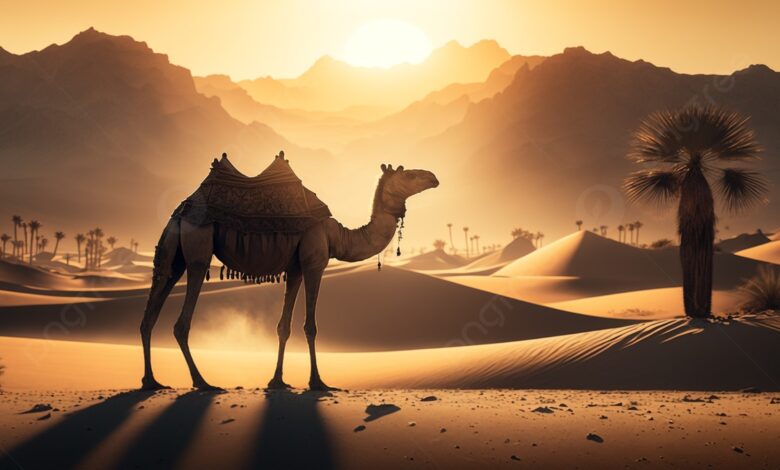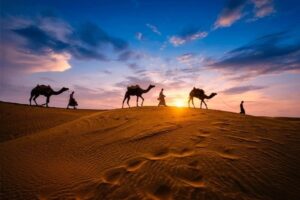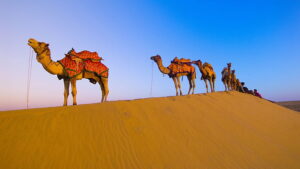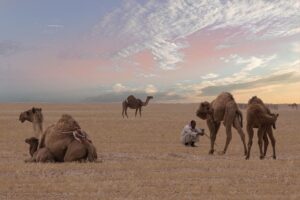Camels in the Desert Majestic Creatures of the Desert

Camels belong to a group of animals known as camelids. They are close relatives of llamas, alpacas, guanacos, and even vicunas, all of which are indigenous to South America. The three types of camels in the desert exist in the present, and most of them are domesticated. The dromedary with one hump (Camelus dromedarius) is found in dry regions of Africa and Asia, as well as those in the Sahara Desert and the Middle East. The domestic Bactrian camel (Camelus bactrianus) can be found all over Central Asia, and the wild Bactrian camel (Camelus ferus) is found in remote regions in Mongolia as well as China, which can be found in remote parts of China and Mongolia. It is extremely endangered. Wild and domestic Bactrian camels both have two humps.
Why do camels have so many humps on them?

Humps on camels in the desert are frequently connected to their capacity to travel for lengthy durations without having a drink. However, they do not store the water they drink in their humps. Their humps, instead, are made out of oil. Camels in the desert usually live in areas with little water or vegetation. They can store fat transformed into energy when they cannot access the necessary resources to live. To survive for long periods in desert areas, the camels have also adapted to minimize their water consumption. shed. As an example, they have extremely thick and syrupy urine, and their feces, are dry enough that they can be utilized as fire-starters. The camel may also make use of its nose to act as a dehumidifier. Inhaling our breath, the air that we exhale remains at body temperature, and it loses water in the form of vapour. However, when the air flows out through the mucous membranes of a camel, it cools, and the water vapor is taken out and absorbed by the body. It prevents them from losing water with each breath. Camels in the desert can withstand losses as high as 70% of their body weight in water. This is significantly more than the majority of animals could endure. They can’t live without drinking water for a long time. Camels can drink large amounts of liquid quickly; however, they do not store the liquid in the future, so it’s only enough to hydrate themselves. The camels that live at Knowsley Safari are Bactrian Camels Also commonly referred to as Mongolian Camels. The Bactrian camel is estimated to have around 240 individual hairs per square centimeter. It means that they’re covered with an extremely thick coat that protects their bodies from cold weather and the blustering wind. In colder seasons, the camels develop a thick coat of woolly fur that completely covers their body, including their hump. As temperatures begin to fall, the camels also develop a thicker outer coat of hair. The extra coat could reach up to 30cm at times and helps keep the camel warm in winter.
Extreme Cold and Extreme Heat are Not problems for the Camel

Camels have evolved to survive in harsh environments that are both cold and hot. In contrast to other mammals, the majority of the fat of camels in the desert is kept inside its humps. This permits better thermoregulation. This makes it simpler for the animals to expel body heat when they are in hot conditions. Camels in the desert don’t sweat much. They’re much more adept than humans at coping with hot temperatures. The body temperature fluctuates during the day due to an increase in temperature, while dropping in the evening when temperatures are cooler. This may sound odd, but camels have fur when they are found in scorching deserts, however, their fur coats serve to provide insulation and shield their bodies from scorching extreme heat. Camels in the desert with horns are more likely to sweat. Sand in the desert can be extremely hot so they have thick and heat-resistant pads for their knees, feet, sternum, and elbows so that they can lie down and not be burned. Additionally, they lack the stifle fold. Like other mammals, it is the skin stretch between the abdominal area and the legs. Camels in the desert don’t have it, which means that when they’re in a position to lie down, air will remain circulated under their bodies. However, while they are typically believed to be found mostly in hot climates, some are discovered in colder regions. Bactrian camels from Central Asia, for example, have to contend with freezing winters and heat-scorching summers. They’re well-adapted, however, they have thick fur that keeps their bodies warm during the cold. The coat sheds quickly once their environments begin to get warmer. Camels are historically adapted to harsher climates, and there is evidence of extinct species located within the northern Arctic Circle. Camels in the desert survive in the dryest and hottest areas of the planet Earth. They manage to feed themselves But what can they consume in areas that look like they are devoid of life? Three species of camels, namely Camelus dromedarius, Camelus bactrianus, and Camelus ferus, have developed various adaptations that allow for living in the desert, according to the Natural History Museum, London (NHM). Apart from the two or three humps that they wear, which are constructed of fat, and therefore do not function as water tanks, they also have specially designed lips that are designed for eating desert food. They feature a split upper lip, with both halves moving independently to let the animal move closer to the ground to consume small grasses. This is essential in deserts, in which everything grows slowly, according to San Diego Zoo. San Diego Zoo.
How Do Camels in the Desert Survive?

Sand, as well as other soft surfaces, are difficult to walk across. Being buried in the ground can mean you exert greater effort and endurance for every step. Camels weigh as much as 1000 kilograms. Males are generally heavier and bigger than females. Instead of small hooves, camels in the desert have large, snowshoe-like feet, with two toes. The size of their feet and the circular form of their feet aid the camels in distributing their weight and prevent the feet from sinking. Even though you won’t supply your eyelashes much, they serve a critical purpose because the eyes are the eyes’ first line of defence. The sensitive eyes of our youngsters are protected from dirt and debris using eyelashes. This can be particularly crucial for camels in the desert, which often live in dusty, dry areas. The eyelashes of camels are usually observed to be particularly long. The research has revealed that there exists an optimal ratio of eyelashes, and it tends to be about one-third of the size of the eye they shield. Camels possess larger eyes than humans, hence the long length of their eyelashes. If a camel’s thick eyes and brows are bushy enough, and debris gets in their eyes, the animals also have a third eyelid, which can sweep it away like a windscreen wiper. This slim structure is also known as the nictitating membrane. Many other animals are equipped with third eyelids that function, like seals and cats, as well as reptiles, birds, and seals. Camels are also able to stop dirt and sand from entering their noses by closing their nostrils completely. In desert environments, there are a few choices for food sources for herbivore camels in the desert. Dromedaries as well as Bactrian camels mainly are fed by thorny trees that have a high amount of fiber and have access to plants, shrubs, and grasses. Camels can also eat the prickly vegetation. Their tongues and their lips are strong, and their mouths are filled with mouths filled with papillae (fleshy extrusions). These aid in guiding camels to consume their food; however, they also stop them from scratching, poking, or injuring their mouths. After a camel has swallowed, food is absorbed into the part of their stomach, known as the rumen. It can ferment and then soften thanks to microbes. This is then digested by the animal. matter, which is referred to as cud. It then continues after chewing it until it’s swallowed and digested properly. While camels in the desert do ruminate, however, they don’t possess the usual four-chambered stomach that is found in cows that are true ruminants. They are described as pseudo-ruminants. Alongside their fur coat Camels also have a clever adaptation that allows them to stay warm during cold winter days They can alter the blood flow to various areas of their bodies. In the case of a cold, they reduce blood flow to the feet and legs. They also deliver more blood to vital organs in their bodies that require warmth. You may be wondering why a creature from the desert, such as a camel, requires an option to stay warm! Bactrian camels are native to Mongolia. Mongolian desert. If you’re looking for a place on the planet Earth that has the most severe temperatures and difficult weather, Mongolia is the place. The summertime temperatures could exceed +500 degrees in the daylight hours, however, when winter arrives, temperatures can drop to the lows of -400°C during the evening. Camels have a great deal of adaptability to this dynamic climate. One of their most prominent ways of being able to survive in this harsh environment is their two humps on their backs. These humps are where camels can store fat, not water! If food supplies are scarce in the desert, camels use oil in their humps to provide essential nutrition. Animals who live in warmer climates, including bears and whales, can store fat throughout their bodies. It acts as a form of insulation that protects them from the cold temperatures. However, camels must withstand extreme heat and frigid cold. They store extra fat so that they stay cool during the summer months and depend on their super-thick coat to keep warm in desert winters that can reach -400 °C.



